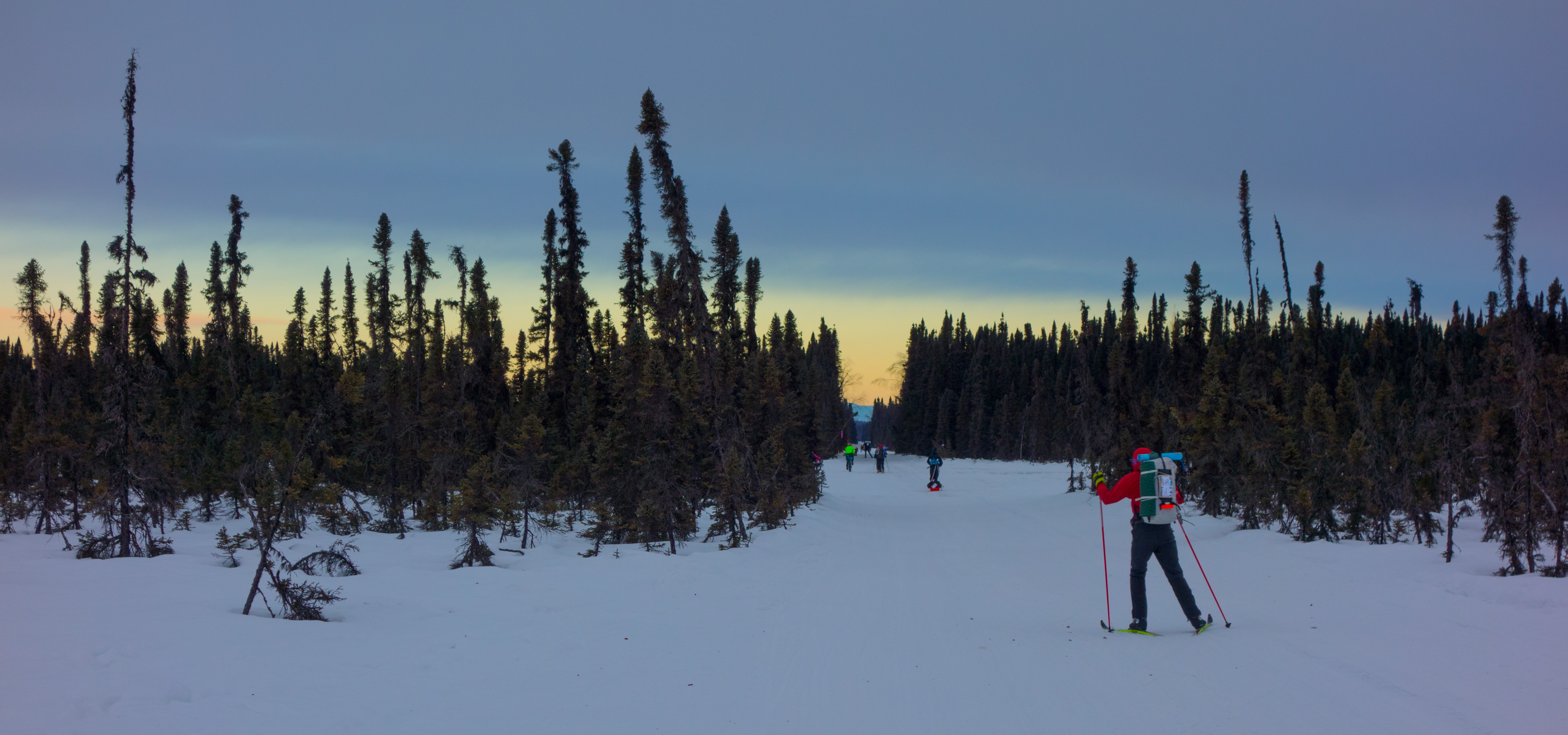
FasterSkier staff regularly report on the world’s fastest skiers on the world’s fastest courses. As a reporter, I’m not an exception, but when I strap a pair of skis onto my own feet, I prefer to go as far as I can, going as slow as I need to go in order to, hopefully, get there.
Ultra-racing has been experiencing exceptional growth in popularity in recent years, and, for once, this is a national trend that Alaska is actually keeping up with. Behind the incredible skiers at Alaska Pacific University lie a lot of skiers like me, a 31-year-old competitive also-ran, along with people that didn’t start skiing until later in life, and a few truly-talented ski racers mixed in there. And we’ve fueled an exceptional growth in wilderness ultra-races statewide, with new races popping up at the rate of a couple per year.
The Susitna 100
I was in Argentina on a climbing trip for a big chunk of the winter, so when I returned to my hometown of Fairbanks on Feb. 5 I had to scramble to arrange some ski fitness for the Susitna 100, which was to be held just 10 days later.
The race was in Big Lake, Alaska, a small town near Wasilla about 50 miles north of Anchorage. It had been a lousy winter in Southcentral Alaska with exceptionally low snow cover. The course was nearly all ice. Most of these winter ultras are multi-sport races, with separate categories for skiers, bikers and runners. The bikers were discussing using studded tires; the runners were discussing using cleated shoes; the skiers were flabbergasted — we didn’t know what to do.

“A hundred miles is a LONG way to double-pole,” I whined emphatically. “And I can’t skate that far – not with how little skiing I’ve done this winter!”
In the end, I went with a regular pair of classic-racing skis that I used grip tape on for kick. I applied the grip tape very carefully, as I had been warned was important.
It didn’t matter, because even grip tape won’t kick on ice. And even if it did, that didn’t matter either, because within a few miles the grip tape had completely rubbed off, and I skated the remaining 95 miles on my classic skis.
The Susitna 100 course is a giant loop, starting on a path very similar to the famous Iditarod sled-dog race. The other racers and I ground our way across features with names such as the Dismal Swamp, the Big Swamp, and large sections of the frozen Susitna River. A swamp, in the winter, is effectively just a vast, open plain.
“I think I could make a noose out of the waist strap on my pack,” I told one of the other racers as we crossed the five miles of swamp, “But none of these trees could support my weight.”
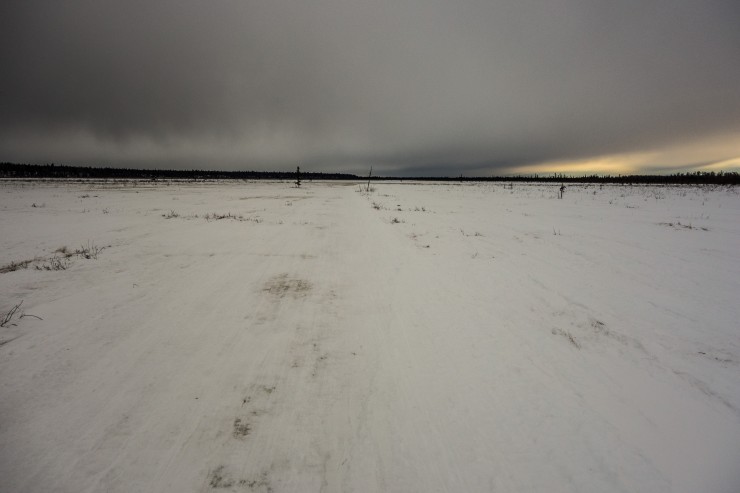
And we were supported along the way by cheerful volunteers, even as we the racers became less and less cheerful.
The multi-sport nature of the races means that people on the trail can have quite different experiences. Fatbikes have been enjoying a recent explosion in popularity, and snow-starved Southcentral Alaska has been fueling the explosion. It was a banner year for the cyclists, with the overall winner, Carey Grumelot, blasting the 100-mile course in 8:27. (The Susitna 100 has been around for quite a few years, but this was a new course this year. Though any time would be technically a course record, the courses are comparable and this would hold up as a course record.)
The top skier, Matias Saari, more than doubled that, finishing in 17 hours, 21 minutes. I finished in 18:02 and was utterly destroyed at the finish line. The top runner, local superstar Dave Johnston, finished in 18:22, which, I hasten to point out, was behind me. Not much behind me, but behind me all the same.
The Wilderness Classic
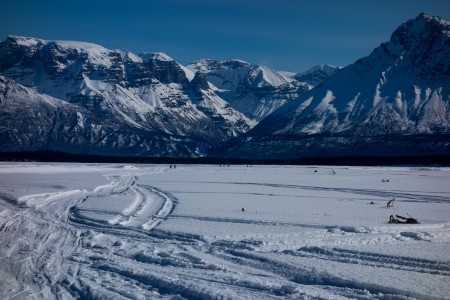
The Alaska Mountain Wilderness Ski Classic is unique. It’s a point-to-point race, through the wilderness, with no set course. It’s like the famous ‘adventure race’ format, except that none of the difficulties are contrived. The winter version of this race (there is also an unaffiliated summer version) changes course every three years.
I had been wanting to do this race since I was a teenager, but first I couldn’t get out of my college classes, and then when I got a little older and a little smarter I realized that I wasn’t tough enough for it. Last year I didn’t do it for no good reason, and as soon as I saw the photos afterward I knew that I had made a mistake. This year, finally, I entered.
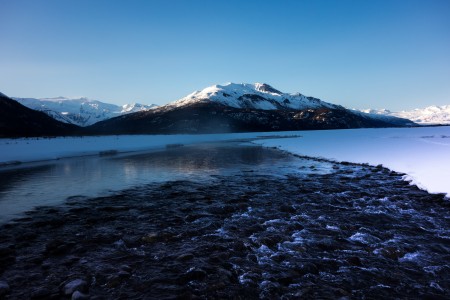
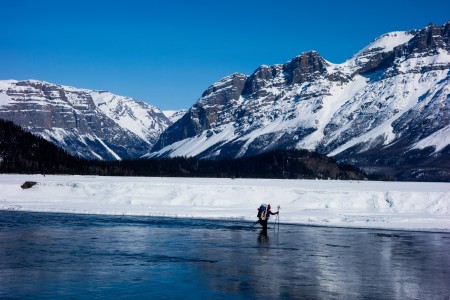
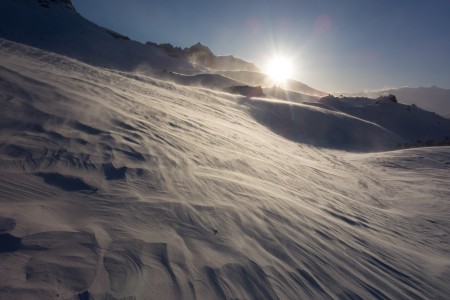
I made it for three days and about 90 miles from March 23-25, sharing the journey mostly with a quiet guy named Miles. I learned quite a bit about Miles from his best friend after he and I had parted ways, and it seems like there was a lot he didn’t say – like that he is a world-class extreme skier (five consecutive top-five finishes at the World Extreme Ski Championships in Valdez) and that his dad Marty Raney is the star of a reality show.
The whole second day was spent skiing through a wind storm. We woke up in the wind and fell asleep in the wind. Miles and I traded leads up Skolai Creek throughout the day. Strong winds can be an intimidating thing, but my trip to Argentina had been in a particularly windy place. I was jaded and approached the day with the sort of fatalistic attitude that a whipping boy might develop.
As day wore into evening, we toured into the blowing snow across the blank expanse of Upper Skolai Creek. It seemed to me a bit like a KKK rally – nothing but all-white hatred and violence.
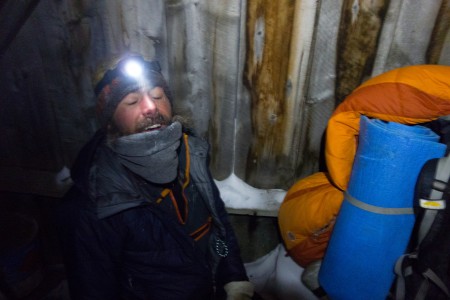
Miles was ahead of me, and as darkness began to press down, I raced to catch him. I knew he didn’t have a tent, and I knew I wanted help setting mine up in the wind. I saw the possibility to cut a deal.
“DO YOU WANT TO CAMP?” I shouted through the wind.
“I WAS LOOKING AT THE MORAINE UP THERE.” Miles replied, obviously referring to the task of finding shelter and hoping to find some at the jumbled moraine of the Russell Glacier.
“IT COULD BE EVEN WINDIER UP THERE. WHAT ABOUT THESE WILLOWS WE JUST SKIED THROUGH?”
“THAT SUCKS.”
I shrugged.
“HOW ABOUT OVER THERE AT THE BASE OF THOSE PEAKS?”
Without a word, I headed where he pointed. As I closed in on a clump of willows, I saw a large rock in the dim light of the evening (I was actually still wearing my sunglasses to protect my eyes from the blowing snow).
Suddenly, the rock took a defined shape.
“WHOOOOO HOO!” I shouted back to Miles. What emerged from the snow was unmistakably a roof.
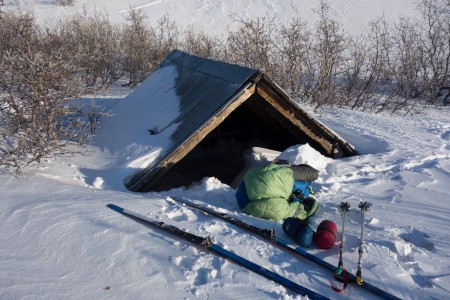
It wasn’t much of a cabin, just three low walls and a roof, but until that moment I had been trying to figure how I was going to get the tent out of the bottom of my pack without all the other contents of my pack blowing away.
We slept nine hours that night.
The following day was just an upwind battle down the Russell Moraine, into the White River Valley and then over Solo Pass.
My boots, which are pieces of junk, were soaked nearly the entire race from a combination of sweat and melting snow seeping into the boots. Once the temperature dropped in the evening, my boots would begin to freeze. For example, on the second night, I was alarmed to discover that my sock was frozen to the inside of my boot. When I pulled my boot off, the sock stayed. A separate problem was that my toes were becoming numb from being crammed into the ill-fitting and soaked boots. Though my toes weren’t (especially) cold, the realization that the freezing point was so close to my insensible toes was pretty alarming. I had carried on, remaining vigilant as to the temperature of my feet.
On the third night Miles and I skied late into the night, intent on arriving at a public use cabin in the tiny “town” of Chisana (say “shoe-shanna”).

As I skied my feet had become soaked and painfully wrinkled, and I realized that I was cruising for blisters and trench foot.
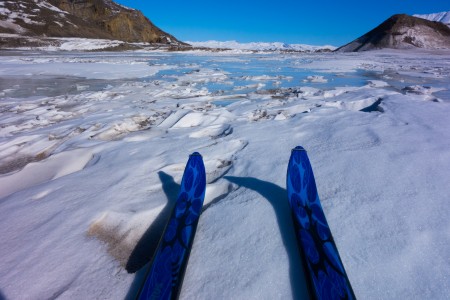
I stopped to change socks.
The daytime high temperatures on top of the pass had been above freezing. But interior Alaska is known for strong temperature inversions, and the overnight low at the valley bottom was -18 degrees Fahrenheit. By the time I put my boots back on, they had frozen solid.
Stomping swollen, blistered feet back into frozen boots is a joy that every skier should experience at some time in their life. Frozen boots don’t bend, which means that, in order to stride, your foot is forced to move independently of the boot. If you’ve already got heel blisters, this is not an appealing option. Though I was able to skate without too much pain, pushing the metal-edged skis across the cold, squeaky snow in the middle of the night with a pack on was an effort I could only manage for moments at a time. Instead, I mostly did a quarter-mile-per-hour shuffle. Eventually, I found Miles laying in his sleeping bag in the middle of the trail.
“We’re only a mile from Chisana.” I said.

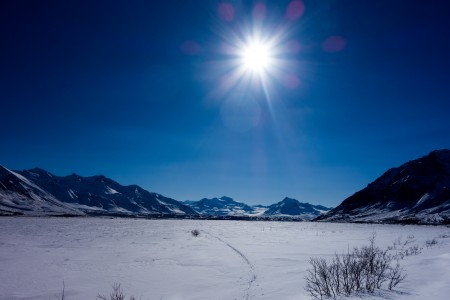
“Oh?”
We debated the merits of continuing on or just crashing there (it was now very late at night). I needed a wood stove to warm and dry my boots if I was to have any hope of finishing the race. Plus, I knew that my +30F bag was not going to offer me a warm and pleasant night of sleep in temperatures that appeared to be dipping into the double-digit negatives. It was cold, and Miles agreed that a wood stove sounded good. He climbed out of his sleeping bag and we continued down the trail.
We were assured that the public-use cabin in Chisana would be easy to find. Long story short, it was not, and I regretted each and every painful footstep that I spent touring around looking for it. Miles found a cabin that was open, although it had signs up that very clearly threatened death upon anyone caught trespassing (an almost-endearing Alaskan tradition). We trespassed.

The cabin was open because the door had been knocked in by a bear. If you’ve never seen a cabin that has been trashed by a bear, the mess that they make is both gratuitous and truly astounding. Nothing with the slightest odor of food is left in place, and, as a testament to their strength, I’ve seen full-sized refrigerators tossed across the room in what would appear to have been an off-hand gesture. They often rip the walls open for no obvious reason.
Following the bears come the mice, and following the mice come the ermine. The squirrels come and make nests out of the insulation in the walls. And following all of these comes a layer of feces covering everything. My moral dilemma about trespassing on private property was becalmed by the realization that we really couldn’t make things any worse.
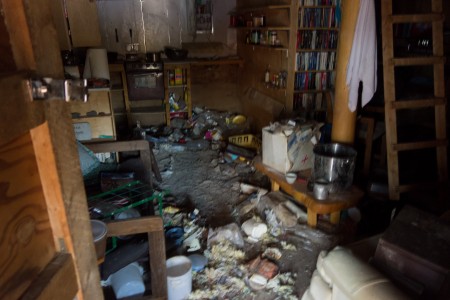
Miles sacked out almost immediately on the bed. There was a wood stove, but hardly any point in building a fire since the cabin door had been torn off. I found a cushion in the loft, a sleeping bag I could pull on over my own, and a not-too-filthy spot. I dove into my bag wearing all of my clothes. I stuck my frozen boots into my sleeping bag with me. It was nearly 5 a.m.
Around 8:30, sunlight and the sound of Miles moving woke me up. I was surprised to realize, that in spite of pounding nearly a liter of water before bed, I didn’t have to pee. This thought was then immediately interrupted by the overwhelming need to pee.
My boots were still frozen solid after a short night in my bag with me. I grunted in pain as I jammed my feet into them. I rushed to throw my leg over the ladder to descend from the loft and escape outdoors to relieve myself, and in the process felt about a half a cup of urine run down my leg. I had hit rock bottom.
The previous night I’d had to pour boiling water on my bindings to get my boots out. My bindings were now frozen solid. By this time, I realized I had very few workable options with respect to my boots. Even if I succeeded in thawing them out, I could not keep them dry. If they froze on my feet again, which they surely would that coming evening, I would basically have to camp wherever I happened to be when they froze. Then I would have to stay in my tent until my boots were thawed enough to move again. In other words, I needed to ski far fewer hours per day. With 90 miles of wilderness between me and the finish, this was a bad option.

Add the looming danger of frostbite or the chance of long-term numbness in my toes from trench foot (something I’d done before under more-innocent circumstances), and I knew I could do lasting damage to my feet.
There was an occupied-looking cabin across the airstrip that ran through the roadless town. Miles and I skied over there either to ask whether we could borrow their heat or, if not, where the public-use cabin was.
Even though it was only about 200 yards away, Miles beat me there by about 10 minutes. I was merely standing on top of my skis, rather than clipped in, since my boots and bindings were frozen to unworkability.
Miles introduced himself to the residents, and Adam, who was soon to be one of my favorite new friends, came out to see me shuffle over.
“There are pancakes and coffee inside,” he shouted at me as I made agonizingly-slow progress through the morning sunlight.
In that moment, I dropped out of the race.
After I ate all of Adam and Samantha’s pancakes and drank all of their coffee, I allowed myself to be chauffeured on a snowmobile over to the public-use cabin, which was indeed tucked away in an obscure spot. Adam and Samantha, it should be noted, are two of the nicest people I’ve ever met, and did innumerable favors for me and the other racers in the course of two days. Miles, a true hardperson, turned down the food (it is against the rules to accept outside help), but did stand by the fire for a few minutes to warm and thaw his own boots. He’d had less than four hours of sleep that night, and after less than a half hour warming his boots in Adam and Samantha’s house, he continued on down the trail.
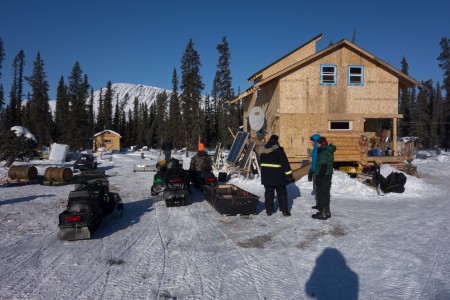
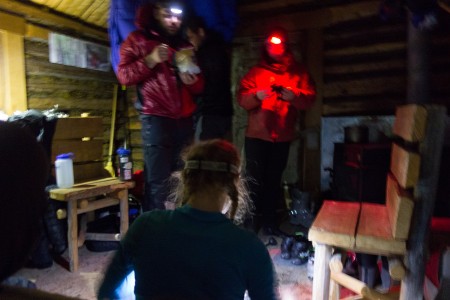
Miles and I had been in the front of the pack that followed the Skolai Creek route. Other racers trickled in throughout the day, until there were 10 of us staying in the two public-use cabins. Three of us, excluding Miles, decided to withdraw from the race due to battered feet. Racers can accept help from other racers, and, given the “we’re all in this together” attitude towards the event, there was a party of redistribution as folks that were scratching gave extra food, fuel, batteries, band-aids, and other miscellaneous items to those that were continuing.
The next day, myself and the two other bailers got in a Cessna 185 and flew to Tok.
Two-and-half days later, Miles crossed the finish line as the first finisher from the Skolai route, less than an hour behind the top finishers, Team Brad Marden and Josh Mumm who finished first, followed closely by Team Andrew Cyr and Danny Powers, all of whom did shorter but more technical high-alpine routes (solo travelers cannot do the glacier routes, as crevasse falls are a real danger).
As I sat in the Cessna, wearing a borrowed pair of down booties, and flew over the empty expanse of the Wrangell Mountains, I couldn’t sit still. My feet were wrecked and my boot choice was a disaster, but the rest of me was in fine shape.
It was Thursday, and the White Mountains 100 started on Sunday. I had won a lottery spot for that race, but assumed that I would scratch since I would be wrecked after finishing the Classic. Scratching from the Classic was a bitter pill to swallow, but I began to think that the White Mountains 100 would make a nice consolation prize, indeed.
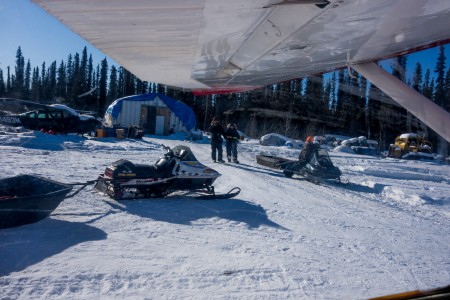
The White Mountains 100
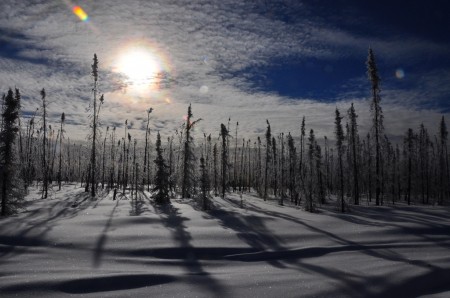
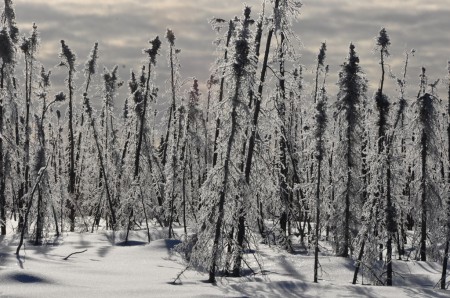
Immediately after its debut five years ago, “the Whites” gained a reputation as being not only Alaska’s premier 100 miler, but really as good of a race as anyone could imagine doing. The 100-mile loop is truly remote, traveling semi-groomed trails through the beautiful White Mountains National Recreation Area. The organization of the race, under the increasingly-reluctant direction of Ed Plumb, is like an honors thesis in race organization: hot meals, warm cabins as checkpoints, hot or cold water, medical care and happy volunteers even in the most remote corner of the course make it a truly pleasant experience.
Having been a pretty dry March, the lightly-maintained trail had gotten wider than usual by the March 29 start. Last year I used classic equipment for the course, which proved to be the right choice, as it was pretty cold and everyone on skate skis had suffered in the slow conditions. This year, the course was wide and the forecast was for pleasantly warm weather. That, combined with the still-raw blisters on the backs of my heels, made me figure skating to be a much safer bet. I grabbed skate skis, combi boots, and slightly shorter-than-normal skate poles.
Unlike the Classic, the Whites proved to be a pretty uneventful race. I’m not a guy with a strong competitive streak, so in order to save energy early in the race I mostly popped my skis off and walked up all the steeper hills (for whatever reason, the trail tends to be a bit narrower on the hills, too).
I arrived at the halfway mark in the race, the beautiful Cache Mountain Divide, at about 2 in the afternoon. I took a break at the next checkpoint, Windy Gap, and then covered the next 20 miles to Borealis (these are the names of the reservable cabins in the rec area that serve as race checkpoints) in only 2.5 hours, arriving with the glorious evening sun still trickling through the trees. Given that the previous year I had arrived here at one in the morning in a snow storm, I could hardly believe how quickly the race was going.
The final 20 miles are always tougher than the previous 80 put together, and this year was no exception. I battled my way to the finish line with a sense of utter futility.
“We’re almost there,” my friend Sam Herreid said as he ambled past me.
“No we’re not!” I wailed in response. “We have like five more miles!”
I finished in fourth place at exactly midnight, in exactly 16 hours. Given that the previous year I had finished in second place in nearly 23 hours, one can see what a difference conditions make.
Here I Make a Plea/Call to Action
The Whites, like the Susitna 100, is a multisport race. All of the other divisions set course records: Josh Chelf knocked almost 2.5 hours off of the bicycle record, finishing in less than 8 hours. On the women’s side, Amber Bethe broke the record set by the unbeatable Heather Best (she didn’t race this year) by finishing in 10.5 hours. Colorado visitor Joe Grant smashed more than 12 hours off of Laura McDonough’s running record, finishing in slightly more than 17 hours (likely the second-fastest 100-miler ever run in Alaska, and maybe the fastest 100-miler ever run on snow, anywhere).
For her part, McDonough beat her own record by around four hours, establishing a new women’s record. Just to keep it weird, my friend Elliot Wilson rode the damned race on a unicycle, finishing in just over 18.5 hours, in all likelihood setting a world record (if anyone has heard of this being done before, let me know).

The skiers? We didn’t come near the old records. What this means is that no one fast showed up. The men’s and women’s winners, Max Kaufman and Laura Gutierrez, respectively, are friends of mine and hopefully they’ll stay that way even after they read this. But with only 11 skiers out of 65 racers, one can only conclude that the skier turnout was a bit pathetic.
The men’s ski record is held by someone likely familiar to FasterSkier readers: Rob Whitney. At an astonishing 11.2 hours, this is a record that will put up a fight. I don’t expect the APU ski team to blow off the World Cup Finals to train for a 100-mile race through the sticks, but Alaska is filled with exceptionally talented retired racers, and they should be entering these ultra-distance races and pulling skiing out of its current slump. You know who you are, and if you don’t, I expect your friends to forward you this link in an effort to shame you.
And if you’re not from Alaska? I’ve traveled a lot, and I’ve come to the conclusion that there is no where in the world that I would rather be during the month of March than Fairbanks, Alaska. That might sound like hyperbole or the setup for a joke, but no, really, it’s true. With more sunshine than anywhere in North America and daytime temperatures that usually hover just below freezing, you can’t ask for better. So skiers? Step it up. For the love of Pete, please bump jokers like me out of the top 10.
You Too.
A lot of people’s response to the idea of entering a 100-mile race is “no way I could do that.” But you’d be surprised – it’s far more doable than it seems (after all, even I can do it). If you’re tired, but not dead, after a 25-mile ski, then a 100-mile race is probably within your abilities. Just spend some time learning your body and learning what food and pace work for you, and then the leap is much smaller than you think.
A few internet searches will turn up the races nearest you, and I think you’ll find that long races are a great format and have a fun crowd of participants, where all the other racers immediately become automatic friends. So wax up your skis and prepare to go slow!

.

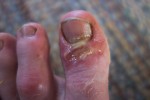

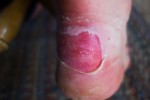





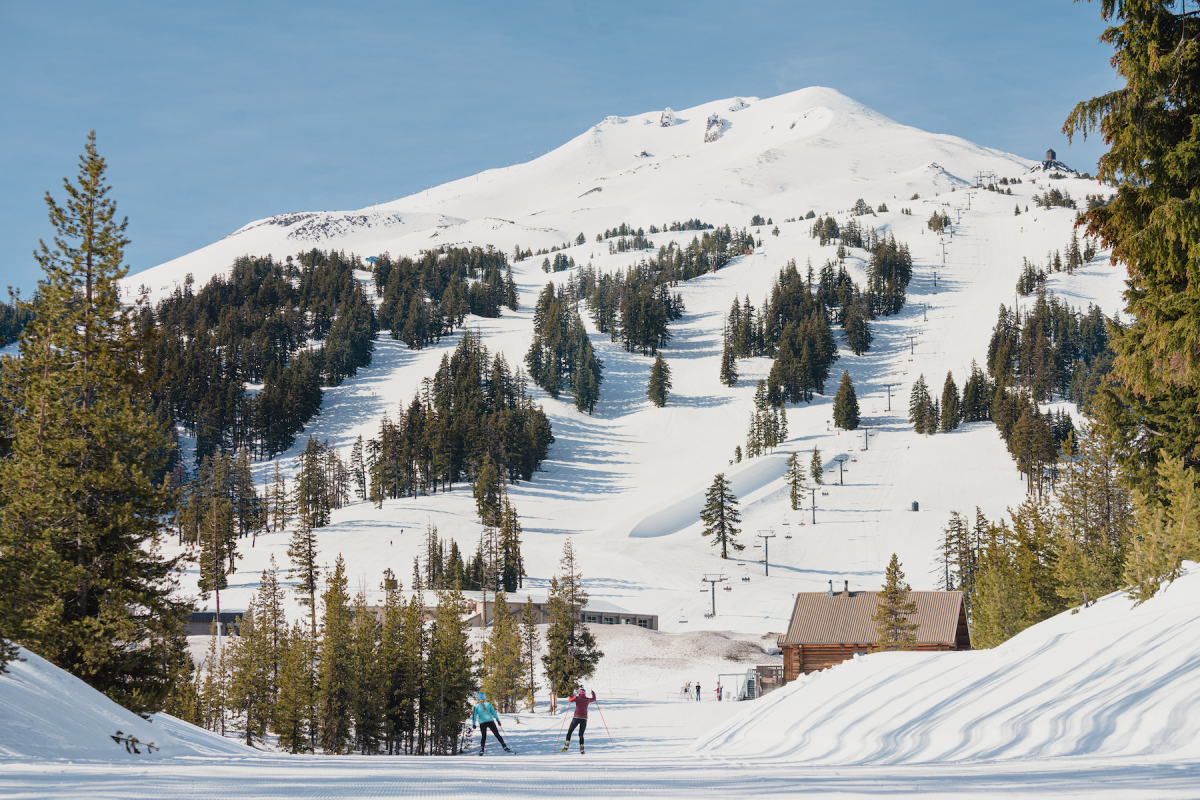
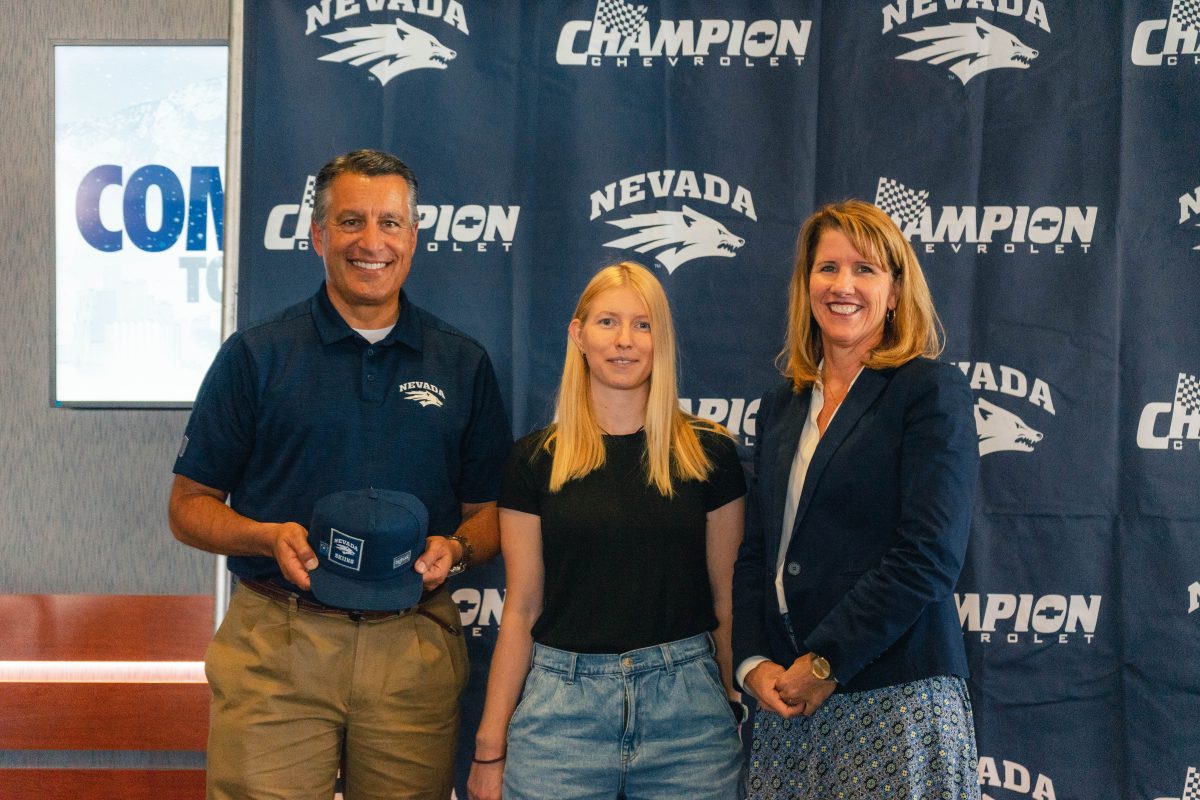
3 comments
cleistikow
April 11, 2014 at 5:10 pm
Great article, Seth! And if you think you can’t ski 100 miles check out my husband and my article today in the Fairbanks News-Miner. http://www.newsminer.com/features/outdoors/fairbanks-couple-completes-white-mountains-on-skis/article_c0bc4032-c150-11e3-8fb4-001a4bcf6878.html
We are back of the packers. We aren’t fast but we can keep moving. So give it a try. This race is incredible and fun and miserable at times – at least for us slow people!
Tim Kelley
April 13, 2014 at 1:01 pm
It’s good to see the younger generation of skiers defending the faith in AK ultra races. The game has surely changed. In the 80’s there’d be 40-50 skiers doing the 200 mile Iditaski. Now you sometimes get only a tenth of that number of skiers in ultras since fat bikes/snow bikes were invented. And thanks to the upsurge of grooming remote trails and increase in snowmobile traffic – fat bikes are usually a faster mode 80-90 percent of the time. Oh well. Also remember – AK has zillions of miles of trails. So if you want an ultra-distance adventure, you don’t always have to pay someone to tell you where to ski. Just pick a long loop or point to point and go ski it.
gkentch
April 13, 2014 at 7:04 pm
Boring story about me: I did the Su 100 this year with an ancient pair of combi skis that I found in my brother’s basement. I brought kick wax just in case, which is cute/ridiculous in retrospect (though it always could have snowed 6″), and carefully applied multiple layers of glide wax and LF Black ahead of time, which is cute/ridiculous in retrospect. Like you, I had no wax left after 5 miles. But at least I was skating on combi skis, not classic skis, for the remaining 95 miles.
More interesting story about someone else: It has been suggested that seeing Rob Whitney ski by en route to his WM 100 course record was “the most impressive athletic achievement” the speaker had ever seen. Coming from Erin Trochim, who I think was on the Canadian national team or at least a very high-level development skier, this was impressive.
– Gavin Kentch